-
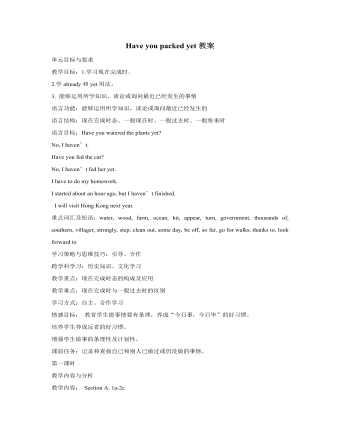
人教版新目标初中英语九年级下册Have you packed yet教案
教学目标:1.学习现在完成时。2.学already和yet用法。3. 能够运用所学知识,谈论或询问最近已经发生的事情语言功能:能够运用所学知识,谈论或询问最近已经发生的语言结构:现在完成时态、一般现在时、一般过去时、一般将来时语言目标:Have you watered the plants yet?No, I haven’t.Have you fed the cat?No, I haven’t fed her yet.I have to do my homework. I started about an hour ago, but I haven’t finished. I will visit Hong Kong next year.重点词汇及短语:water, wood, farm, ocean, hit, appear, turn, government, thousands of, southern, villager, strongly, step, clean out, some day, be off, so far, go for walks, thanks to, look forward to学习策略与思维技巧:引导、合作跨学科学习:历史知识、文化学习教学重点:现在完成时态的构成及应用教学难点:现在完成时与一般过去时的区别 学习方式:自主、合作学习 情感目标: 教育学生做事情要有条理,养成“今日事,今日毕”的好习惯。培养学生养成反省的好习惯。增强学生做事的条理性及计划性。课前任务:记录和查找自己和别人已做过或仍没做的事情。
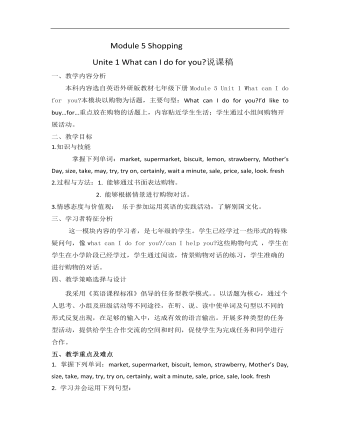
初中英语外研版七年级下册《Module 5 Shopping》说课稿
二、教学目标1.知识与技能掌握下列单词:market, supermarket,biscuit, lemon, strawberry, Mother’s Day, size, take, may, try, try on,certainly, wait a minute, sale, price, sale, look. fresh2.过程与方法:1. 能够通过书面表达购物。2. 能够根据情景进行购物对话。3.情感态度与价值观:乐于参加运用英语的实践活动,了解别国文化。
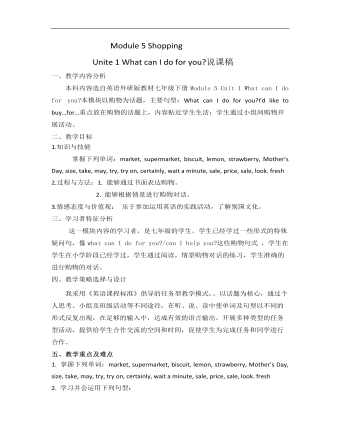
初中英语外研版七年级下册《Module 5 Shopping》说课稿
二、教学目标1.知识与技能掌握下列单词:market, supermarket,biscuit, lemon, strawberry, Mother’s Day, size, take, may, try, try on,certainly, wait a minute, sale, price, sale, look. fresh2.过程与方法:1. 能够通过书面表达购物。2. 能够根据情景进行购物对话。3.情感态度与价值观:乐于参加运用英语的实践活动,了解别国文化。三、学习者特征分析这一模块内容的学习者,是七年级的学生。学生已经学过一些形式的特殊疑问句,像what can I do for you?/can I help you?这些购物句式 ,学生在学生在小学阶段已经学过,学生通过阅读,情景购物对话的练习,学生准确的进行购物的对话。
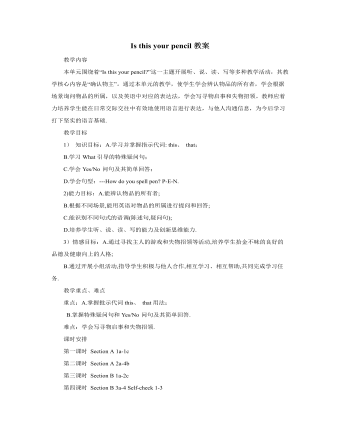
人教版新目标初中英语七年级上册Is this your pencil教案
T: Please look at the pictures and learn the new words.(用多媒体展示新单词效果较好。)1.at prep. 在(里面或附近);在(点刻);2.theart.表示特指的人、物、事或群体 3.lostadj.丢失的;遗失的4.Found adj. (find的过去式、过去分词)找回的5.lost and found 失物招领6.please adv.请7.school n. 学校8.a set of一套;一副(Teach students to read the words.)2. Practice the new words. (事先录制一段短的听力,让学生通过听的训练来强化所学的新单词,并为学习写寻物启示和失物招领作好准备。)T: Please listen to a short passage twice then fill the blanks using the words we learned.(Show students a short passage and play the recording for the students to listen.)There are many things in (1)_____________________in my (2)__________. Look, here’s (3)_________keys. Is this yours? (4)__________call Jim (5)___________753-2289.Typescript:There are many things in the Lost and Found in my school. Look, here’s a set of keys. Is this yours? Please call Jim at 753-2289.
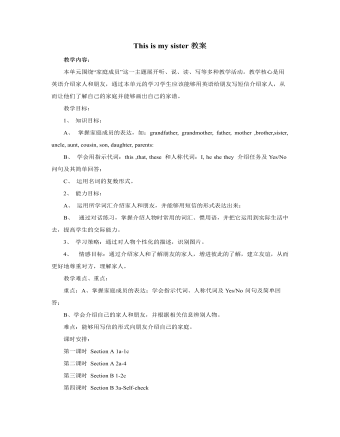
人教版新目标初中英语七年级上册This is my sister教案
(Play the recording twice again.) (Check the answer.) ③Pairwork. Draw your own picture and talk about it. T: We find out the picture of Lin Hai’s family. Can you draw a picture of your family? SS: … T: OK. When you finish drawing, tell your partner about your picture. You can use “This is …” and “ These are …” to talk about. Then report it to the class. (Students work.) (Check students’ work. Ask two or three students to report.) Step Three: Task. Talk about the family tree. T: Look at the family tree. I think it’s a big family. You can do it in groups of four or three. You can do it in pairs or only by yourself. Then report it to the class. (Students work. Teacher walks around in the classroom and helps the students.) T: Stop here. Let’s check it out. (Choose students to do it.) S1: Look at my family tree. This is my… This is my … They have two … This is my … This is my …This is my …This is my. My parents have two children. This is…This is my …My uncle and my aunt have a son. He is my … (Ask two more students to do it.) Homework. Write a passage about your family.
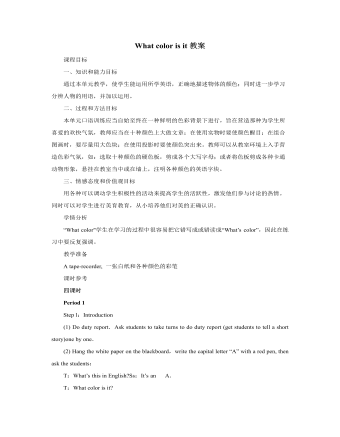
人教版新目标初中英语七年级上册What color is it教案
一、知识和能力目标通过本单元教学,使学生能运用所学英语,正确地描述物体的颜色;同时进一步学习分辨人物的用语,并加以运用。二、过程和方法目标本单元口语训练应当自始至终在一种鲜明的色彩背景下进行,旨在营造那种为学生所喜爱的欢快气氛,教师应当在十种颜色上大做文章;在使用实物时要使颜色醒目;在组合图画时,要尽量用大色块;在使用投影时要使颜色突出来。教师可以从教室环境上入手营造色彩气氛,如:选取十种颜色的硬色板,剪成各个大写字母;或者将色板剪成各种卡通动物形象,悬挂在教室当中或在墙上,注明各种颜色的英语字块。三、情感态度和价值观目标用各种可以调动学生积极性的活动来提高学生的活跃性,激发他们参与讨论的热情。同时可以对学生进行美育教育,从小培养他们对美的正确认识。
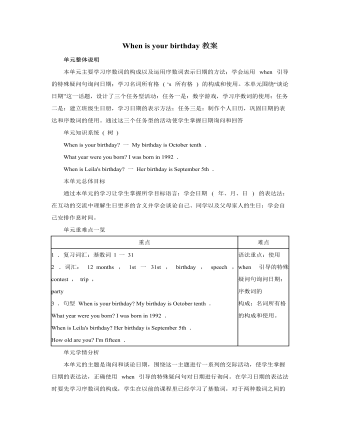
人教版新目标初中英语七年级上册When is your birthday教案
本单元主要学习名词所有格 ('s 所有格 ) 的构成和使用。在初次接触 “ 名词所有格 ” 时,学生较难理解的可能是 “ 所有格 ” 这个名称,对于它的构成,学生也许会觉得较容易。教师可通俗地告诉学生 “ 所有格 ” 的意思是表示 “…… 的 ” ,这样学生反而容易接受。在使用 “ 名词所有格 ” 形式时,学生容易犯错误或混淆的主要是:将这种一 's 构成形式与 is 的缩写形式混淆,如: My father's name's Jin Zhi .,可以这样告诉学生:名词所有格的后面一般应接名词;勿将这种一 's 结构盲目套用与人称代词上,代替物主代词使用,如 He's father's name is Li Cheng 。在教学初期,可不讲授名词所有格的其它形式,待时机成熟,再向学生介绍复数名词所有格形式的结构一 ' ,如: the students' bikes 。 Self Check 教学内容 Self Check( 教材 P52) 教学目标 知识与能力 复习词汇 birthday , date , month , January , February , March , April , May , June , July , August , September , October , November , December , date , birth , age , old , speech . contest . trip , party , event , an , festival , pop , concert , chorus , lecture , music ;引导学生复习、巩固“询问和谈论日期”的目标语言并运用所学知识安排活动。
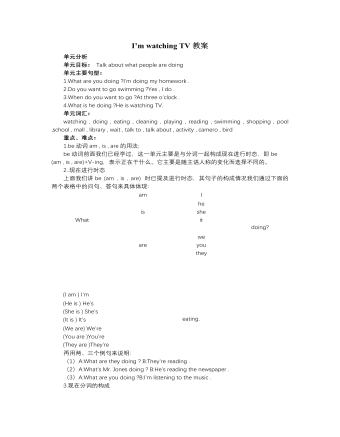
人教版新目标初中英语七年级下册I’m watching TV教案
单元分析单元目标: Talk about what people are doing 单元主要句型:1.What are you doing ?I’m doing my homework .2.Do you want to go swimming ?Yes , I do .3.When do you want to go ?At three o’clock .4.What is he doing ?He is watching TV. 单元词汇:watching , doing , eating , cleaning , playing , reading , swimming , shopping , pool ,school , mall , library , wait , talk to , talk about , activity , camero , bird 重点、难点:1.be动词am , is , are的用法;be动词前面我们已经学过,这一单元主要是与分词一起构成现在进行时态,即be (am , is , are)+V-ing,表示正在干什么。它主要是随主语人称的变化而选择不同的。2..现在进行时态上面我们讲be (am , is , are) 时已提及进行时态,其句子的构成情况我们通过下面的两个表格中的问句、答句来具体体现:3.现在分词的构成现在进行时态中be + V - ing 的构成中V-ing被称为现在分词,它的基本构成是动词原形+ing,但也有些特殊情况,下面分几类说明:(1)一般情况+ing如:read→reading,go→going,do→doing,look→looking,listen→listening,watch→watching.(2)以不发音的e结尾的词,去掉e,再加ing.如:write→writing,skate→skating,type→typing,wake→waking,make→making
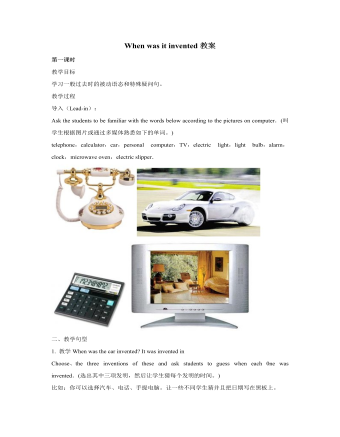
人教版新目标初中英语九年级下册When was it invented教案
二、教学 1a,1b.1.First the teacher asks the students what kind of fruit food and drink you like the best and writes down on the blackboard.教师问学生最喜欢什么水果和饮料并把它们写在黑板上。比如:potato chips,ice cream,tea,lemon,chocolate,oranges,salad,popcorn,pickle and so on.2.接着叫学生表达以上食物的味道,引出新单词——sweet,crispy,salty,sour,delicious,hot,awful,nice…并且完成lb教学内容通过此活动,以旧带新引入新单词。其目的是让学生自主学习新知识。 三、教学 2a,2b1.首先,听力前的brainstormFirst,Let students describe how potato chips taste and describe how helpful the potato chips.Then,ask:When and where were potato chips invented?Who were potato chips invented by?How were potato chips invented?(Let students guess according to the following key words.)Key words:by accident,customer,restaurant,by mistake.(说明:通过问题让学生对对话内容有整体了解,为听力练习做好准备;又培养学生的注意力,想像力,观察力。)
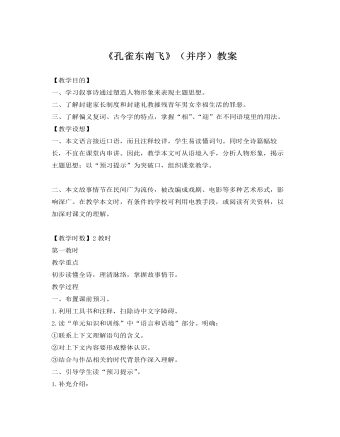
人教版高中语文《孔雀东南飞》教案
3.结合作品的时代背景,进一步理解“黄泉共为友”。故事发生在“汉末建安中”。当时的背景是:汉武帝时,“罢黜百家,独尊儒术”。儒家的那套伦理纲常逐渐占据了统治地位,并发展到了相当完备严密的程度。在婚姻制度方面就规定有“七出”、“天下无不是之父母”等等清规戒律。“天下无不是之父母”,这正是焦、刘悲剧的根本原因。在这一时代氛围里,在焦母的淫威下,焦仲卿敢于站在兰芝一边,表明与兰芝“结发同枕席,黄泉共为友”的坚决态度,实在是难能可贵的。面对儒家所规定的封建家长制度、封建礼教,焦仲卿举起的那面反抗的旗帜,无疑是茫茫长夜中的一道闪电!小结:对语境体察得越充分,对语言理解的深度和广度就越丰富。那么,我们对作品阅读理解的水平就越高。
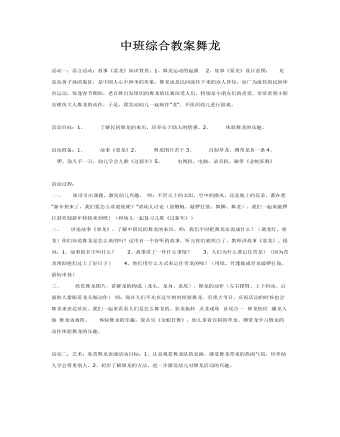
中班综合教案舞龙
活动目标:1、 了解民间舞龙的来历,培养乐于助人的情感。2、 体验舞龙的乐趣。 活动准备:1、 故事《耍龙》2、 舞龙图片若干3、 自制草龙、绸带龙各一条4、 锣、鼓人手一只,幼儿学会儿歌《过新年》5、 电视机、电脑、录音机、磁带《金蛇狂舞》 活动过程: 一、 谈话引出课题,激发幼儿兴趣。师:不管天上的太阳,空中的微风,还是地上的花朵,都在想“新年快来了,我们要怎么欢迎他呢?”请幼儿讨论(放鞭炮、敲锣打鼓、舞狮、舞龙)。我们一起来敲锣打鼓欢迎新年快快来到吧!(和幼儿一起复习儿歌《过新年》)
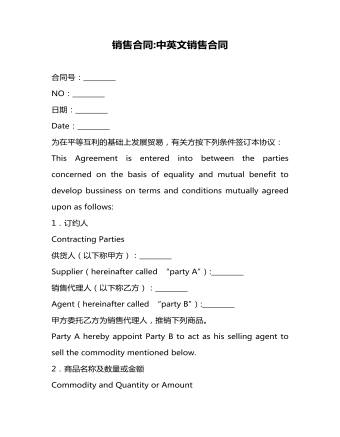
中英文销售合同
在本协议有效期内,乙方在上述经销地区所作广告宣传的一切费用,由乙方自理。乙方须事先向甲方提供宣传广告的图案及文字说明,由甲方审阅同意。
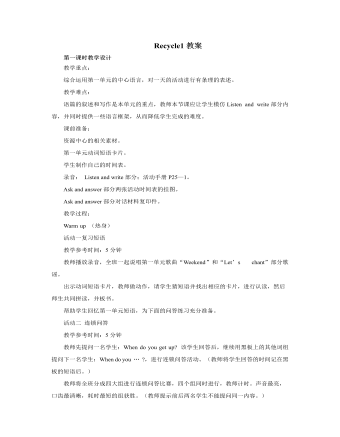
人教版新课标PEP小学英语五年级下册Recycle1教案(内容详细)
学生搜集中外重要节日及部分中外名人的生日所在的月份。教师准备相关节日及部分中外名人的图片或音像资料片。教师课前准备Let’s find out2的配图画好春、夏、秋、冬四个方框。录音:Listen and number。教学过程:Warm up (热身)活动一复习单词教学参考时间:3分钟(1)教师播放Let’s chant部分的歌谣,学生听一遍后跟唱。(2)出示带有各个月份特征的单词卡片。学生看图说出单词,并一起拼读其缩写形式。帮助学生在有节奏的说唱中巩固记忆单词,为在后面活动中学生能够熟练应用作铺垫。活动二 复习句子教学参考时间:5分钟(1)师生同唱Let’s chant部分歌谣“When Is Your Birthday?”。(2)教师引导学生看歌谣下面的翻滚过山车的动画,师生进行问答,如:When is the rabbit’s birthday? It’s in May. 等。教师示范后请学生进行Pair work,也可以展开竞赛的形式进行“连锁问答”。巩固有关生日问答的语句,为Let’s find out1的活动做准备。
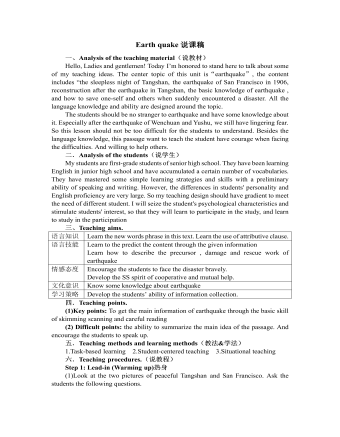
人教版高中英语必修1Earth quake说课稿
(4)Finally, I will ask the SS what this sentence mean:It is always calm before a storm.Purpose: attract the SS attention and bring them into discussionStep 2: Pre-reading 读前Here, I will do the second question in pre-reading first. I will use the method of brainstorming to ask the SS what will happen before an earthquake; and list the phenomenon on the table. 2. Then I will show the SS the picture of abnormal phenomenon, at the same time, encourage the SS to describe.3、finally, I will summarize these phenomenon4、Do the first question in the pre-reading , Imaging your home begins to shake and you must leave it right away. You have time to take only one thing. What will you take? Why?Purpose: help the SS to get further understanding of the topic and stimulate their interests.Step3: While-reading 阅读(1). Skimming Read the text quickly and catch the meaning of the first and second sentence of each paragraph. Predict the meaning of new words(2).scanning(找读)A. Read the text again. Do the following question.1. When and where were the strange things happening?2. What are they?3. Why did the text say the world seemed to be at an end?4. How was the city destroyed after the quake?5. When did the second quake hit the city? What was the result of that?6. Who came to help Tangshan first? And how?B. Work in pairs to discuss the question.
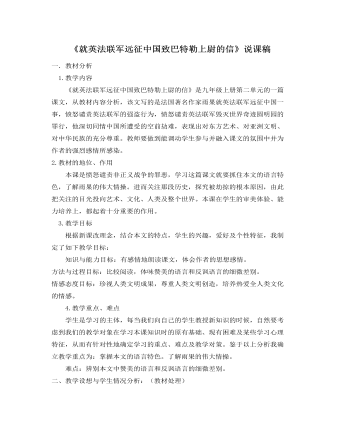
部编版语文九年级上册《就英法联军远征中国致巴特勒上尉的信》说课稿
1.教学内容《就英法联军远征中国致巴特勒上尉的信》是九年级上册第二单元的一篇课文,从教材内容分析,该文写的是法国著名作家雨果就英法联军远征中国一事,愤怒谴责英法联军的强盗行为,愤怒谴责英法联军毁灭世界奇迹圆明园的罪行,他深切同情中国所遭受的空前劫难,表现出对东方艺术、对亚洲文明、对中华民族的充分尊重。教师要做到能调动学生参与并融入课文的氛围中并为作者的强烈感情所感染。2.教材的地位、作用本课是愤怒谴责非正义战争的罪恶,学习这篇课文就要抓住本文的语言特色,了解雨果的伟大情操。进而关注那段历史,探究被劫掠的根本原因,由此把关注的目光投向艺术、文化、人类及整个世界。本课在学生的审美体验、能力培养上,都起着十分重要的作用。3.教学目标根据新课改理念,结合本文的特点,学生的兴趣,爱好及个性特征,我制定了如下教学目标:
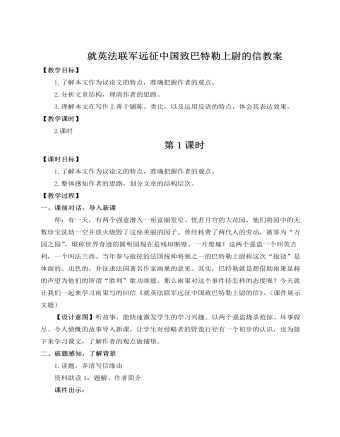
人教部编版语文九年级上册就英法联军远征中国致巴特勒上尉的信教案
【设计意图】以课文为本,积累知识,领会其写法,提高阅读鉴赏能力是必须的,但文中的知识点很多,时间有限,教师不可能面面俱到。故本板块设计侧重反语的表达效果,教师启发引路为辅,学生合作探究为主。三、总结交流,拓展延伸学完本文,我们思绪万千,有对雨果的钦佩,有对英法联军的痛恨,有对清政府的愤懑,有对战争的厌恶……请以《,我想对你说》为题,说一段话,谈谈你的感想。【设计意图】学以致用,才是教学的最好归宿。引导学生与文本中的人、事对话,既可加深学生对所学知识的理解,又可锻炼学生运用知识、独立思考的能力,还能激发为振兴中华而发愤图强的爱国激情。结束语:一代名园圆明园毁灭了,它毁于英法侵略者之手,也毁于清政府的腐败无能。它的毁灭,既是西方侵略者野蛮摧残人类文化的见证,又是文明古国落后也要挨打的证明,我们中华民族不想欺侮其他民族,但也决不能允许别人欺侮我们。少年强,则中国强!同学们,为了中华民族的伟大复兴,为了圆明园类似的悲剧不再发生,我们要勤奋学习,努力奋斗!
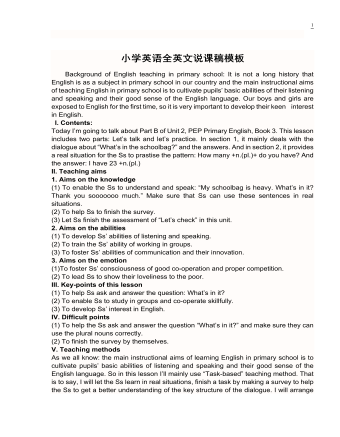
小学英语全英文说课稿模板
1. Aims on the knowledge(1) To enable the Ss tounderstand and speak: “My schoolbag is heavy. What’s in it? Thank you sooooooomuch.” Make sure that Ss can use these sentences in real situations.(2) To help Ss to finish thesurvey.(3) Let Ss finish theassessment of “Let’s check” in this unit.2. Aims on the abilities(1) To develop Ss’ abilitiesof listening and speaking.(2) To train the Ss’ abilityof working in groups.(3) To foster Ss’ abilities ofcommunication and their innovation. 3. Aims on the emotion(1)To foster Ss’ consciousnessof good co-operation and proper competition.(2) To lead Ss to show theirloveliness to the poor.
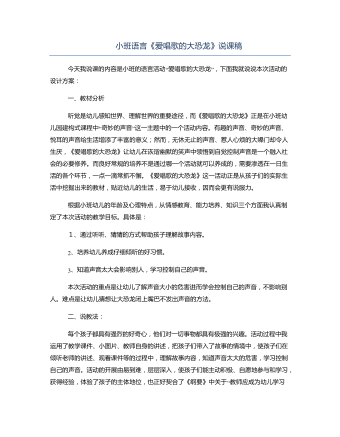
小班语言《爱唱歌的大恐龙》说课稿
每个孩子都具有强烈的好奇心,他们对一切事物都具有极强的兴趣。活动过程中我运用了教学课件、小图片、教师自身的讲述,把孩子们带入了故事的情境中,使孩子们在倾听老师的讲述、观看课件等的过程中,理解故事内容,知道声音太大的危害,学习控制自己的声音。活动的开展由易到难,层层深入,使孩子们能主动积极、自愿地参与和学习,获得经验,体验了孩子的主体地位,也正好契合了《纲要》中关于“教师应成为幼儿学习活动的支持者、合作者、引导者”的理念。此外我还采用了视听结合法、谈话交流法、引导孩子在活动中敢说、敢想,树立了孩子的自信心,从而使本次活动更好地完成教学,形成快乐学习的和谐统一。整个活动我以幼儿为主体,变过去的“要我学”为现在的“我要学”,遵循由浅入深的教学原则,幼儿在看看、听听、想想、说说的轻松气氛中掌握了活动的重点、难点。在活动中教师充分调动幼儿运用讲述法、讨论法、谈话法等学习方法,让孩子学得轻松,感兴趣。
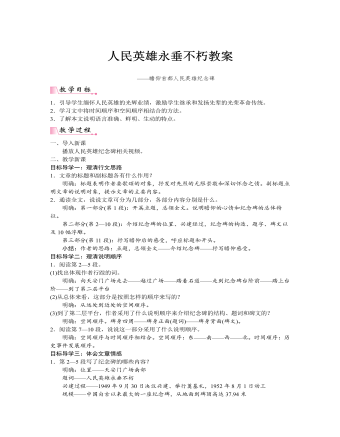
人教部编版语文八年级上册人民英雄永垂不朽教案
这篇文章的语言既有说明文语言准确、严密的特点,又有新闻特写鲜明、生动的特点,请和大家分享你最喜欢的语句,并说明理由。(学生发言)1.准确、严密示例:据地质学家化验证明,这些浮雕至少能耐800年到1000年之久。明确:“据地质学家化验证明”交代数据来源;“至少”对时间进行限定。2.鲜明、生动示例一:深夜,起义的新军和市民,摧毁了湖广总督府门前的大炮,正向总督府里冲去。总督府内熊熊的火焰冒向天空;总督府的牌子,被打断在阶前;撕碎了的清朝的龙旗,被践踏在地上。明确:“摧毁”“冲去”“冒”“打断”“撕碎”“践踏”一系列动词,准确生动地表现了起义者大无畏的革命气概,也揭示了清朝腐朽的本质。示例二:一群男女青年学生,举着“废除卖国密约”的旗帜,慷慨激昂地来到天安门前。梳着髻子、系着长裙的女学生,在向市民们散发传单。人群高处,一个男学生正在向围着他的群众演说。愤激的青年演说者,怒形于色的人群,使整个浮雕充满了痛恨卖国贼、激动人心的气氛。
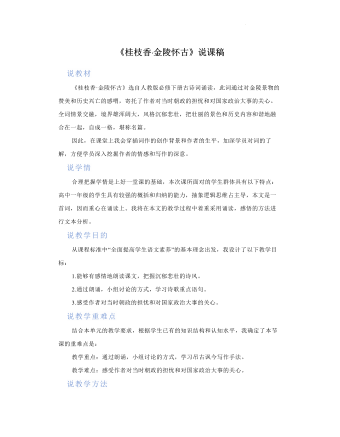
古诗词诵读《桂枝香?金陵怀古》说课稿(一) 2021-2022学年统编版高中语文必修下册
王安石,字介甫,号半山。北宋著名政治家、思想家、文学家、改革家,唐宋八大家之一。欧阳修称赞王安石:“翰林风月三千首,吏部文章二百年。老去自怜心尚在,后来谁与子争先。”传世文集有《王临川集》、《临川集拾遗》等。其诗文各体兼擅,词虽不多,但亦擅长,世人哄传之诗句莫过于《泊船瓜洲》中的“春风又绿江南岸,明月何时照我还。”且有名作《桂枝香》等。介绍之后设置这样的导入语:今天我们共同走进王安石,一起欣赏名作《桂枝香·金陵怀古》。(板书标题)(二)整体感知整体感知是赏析文章的前提,通过初读,可以使学生初步了解将要学到的基本内容,了解文章大意及思想意图,使学生对课文内容形成整体感知。首先,我会让学生根据课前预习,出声诵读课文,同时注意朗读的快慢、停顿、语调、轻重音等,然后再播放音频,纠正他们的读音与停顿。其次,我会引导学生谈谈他感受。学生通过朗读,能够说出本词雄壮、豪放、有气势,有对景物的赞美和对历史的感喟。



